How the lords destroyed the Polish-Lithuanian Commonwealth
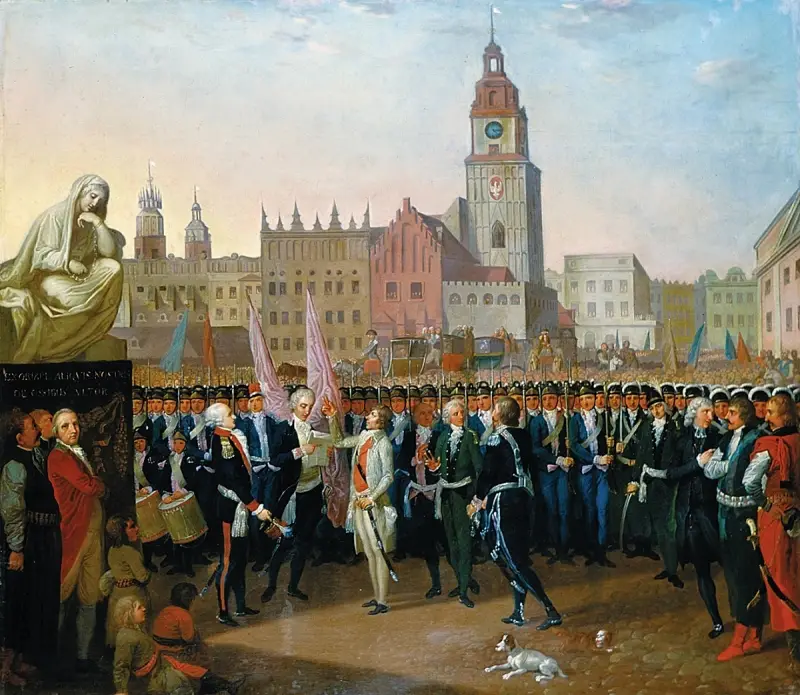
Hood. Francis Smuglevich. Oath of Tadeusz Kosciuszko at the Krakow market
Decomposition of the Polish state
The Polish-Lithuanian Commonwealth reached the peak of its decomposition in the 18th century. The peculiarities of the Polish system of government led to the fact that the previously powerful state gradually fell under the influence of its neighbors. The king in Poland was chosen by the lords, so after the death of the king, a fight most often broke out when various parties of magnates with their gentry proposed their candidates. France, Austria, Prussia and Russia played their own games, trying to place their candidate on the throne.
In the 17th century, Poland reached the highest point of its power when, during the Time of Troubles in Russia, it was able to plant its prince Vladislav in Moscow and set up a garrison. The Russian boyar government served the lords, Polish troops smashed and plundered Russian cities. But the Russian state was able to recover and drive out the invaders.
Further, the Polish-Lithuanian Commonwealth, whose elite was never able to create a stable Polish-Russian empire (Poland itself - Great and Lesser Poland, Polish and Lithuanian Rus), a strong system of government and a regular army, rapidly began to collapse. She lost the battle for the Baltic states to Sweden and could not “digest” Little Rus'. Russian national liberation war led by Bogdan Khmelnitsky (National liberation war of the Russian people against the Polish occupiers) led to a heavy defeat, the loss of the Left Bank of the Dnieper and Kyiv.
The Saxon prince and king of the Polish-Lithuanian Commonwealth Augustus II the Strong (Polish king and Grand Duke of Lithuania from 1697 to 1733, with a break in 1706-1709) began the Northern War with the goal of ousting Sweden from the shores of the Baltic Sea and saw the Russian Tsar as a junior partner . But already during the war, the Polish king became the junior partner of Tsar Peter Alekseevich. Only with the help of Russia did Augustus regain the Polish throne. As a result of the Northern War, Augustus retained the throne of the Polish-Lithuanian Commonwealth, but Livonia, which was claimed by the Poles, went to Russia. Poland itself became a vassal of Russia. Moreover, only because of the goodwill of Peter Alekseevich, Poland retained the Right Bank of Little Rus' (Why Peter I abandoned the Russian Right Bank).
It was beneficial for Russia and Prussia to have the weak Polish-Lithuanian Commonwealth as a neighbor. St. Petersburg begins to support the “Russian party” in Poland - the magnates and gentry who opposed the king’s attempts to consolidate power and end anarchy in the country. It was historical the period when Poland was a peaceful neighbor of Russia.
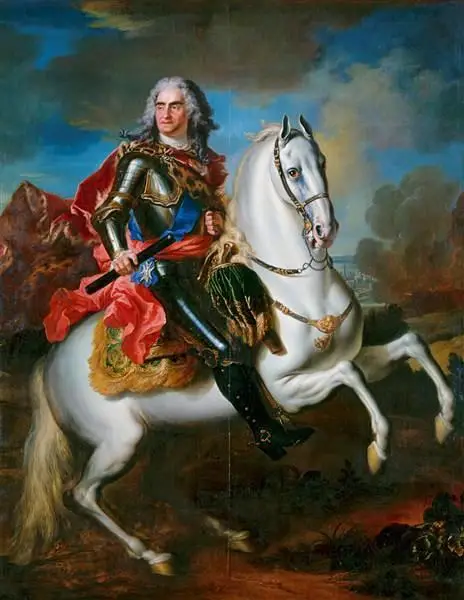
August II Strong. Hood. Louis de Sylvester
Fight for the throne
After the death of King Augustus II (February 1733), the struggle for the throne began. St. Petersburg wanted to maintain alliance relations with the Polish-Lithuanian Commonwealth; it was a matter of national security. Russia had been at war with Poland for too long to give up Warsaw. A hostile Poland, backed by another European power or coalition, is a serious threat.
Therefore, St. Petersburg was going to place a candidate friendly to Russia on the Polish throne. France had long been weaving intrigues and wanted to place Stanislav Leszczynski on the throne, who was already the king of Poland in 1704-1709, fighting against Russia on the side of the Swedish monarch Charles XII. His daughter Maria was the wife of the French king Louis XV. Austria proposed the candidacy of a Portuguese prince. All powers sent significant sums to Warsaw to bribe the lords.
St. Petersburg demanded that Warsaw exclude Stanislav Leszczynski from the number of candidates for the Polish throne. However, the powerful Potocki magnates (after the death of Augustus, the first person of the Polish-Lithuanian Commonwealth was Archbishop of Gniezno Fedor Potocki) possessed “administrative resources.” And Paris sent 3 million livres in gold to bribe the lords, so the majority of the Sejm chose Leshchinsky. Leszczynski himself secretly arrived in Warsaw to immediately take the throne. At the same time, Paris sent a squadron to the Polish shores - 9 battleships, 3 frigates and a corvette under the command of Count Cesar Antoine de la Suzern. Having learned about the “right choice” of the Polish nobility, the French squadron was recalled.
In response, St. Petersburg decided to send a “limited contingent” of troops to Poland - 18 infantry regiments and 10 cavalry regiments, plus irregular forces. The troops were led by the governor of Livonia, Peter Lassi. In Poland itself, Russian troops were supported by opponents of Leszczynski, who created their own confederation. A confederation in Poland was a name given to temporary associations of armed gentry.
September 20 Lassi occupied the suburb of Warsaw - Prague. 22 September Leschinsky fled from Warsaw to Danzig. 24 September opponents Leschinsky chose a king - Friedrich Augustus, the Elector of Saxony, son of the late king. He took the throne under the name of August III.
The war for the Polish legacy continued until the 1735 year. Stanislav Leschinsky sat down in Danzig, hoping for help from France. The Siege of Danzig dragged on from February to June of the year 1734 (The Siege of Danzig). This was due to the lack of forces - the army was chasing Polish troops, and the lack of siege artillery at the beginning of the siege. Attempts by the French squadron to help the fortress failed. The landing of the French ships was unable to break through to the city, was partially blocked and surrendered. Therefore, Danzig capitulated. Stanislav Leschinsky was able to escape, disguised as a commoner.
This war became a good indicator of the decomposition of the Polish nobility, the military gentry class. Most of the rich lords and small gentry took the side of Leshchinsky, they gained significant forces. But they could not help the besieged Danzig, since they were mainly engaged in plundering the property of Augustus’ supporters. Polish soldiers tried to avoid clashes with Russian regular troops; they only disturbed them. They gathered in large crowds near the location of Russian units, burned the estates of their compatriots who were in another camp, and talked about their desire to give battle to the Russians. But as soon as Russian troops appeared, the Poles fled immediately or after several gun shots.
As contemporaries noted, in this war, 300 Russians never left the road to avoid meeting with 3 thousand Poles. They always beat them. At the same time, the Poles were not afraid to fight the Saxons, whom they despised and often beat. They “had great fear” of the Russians.
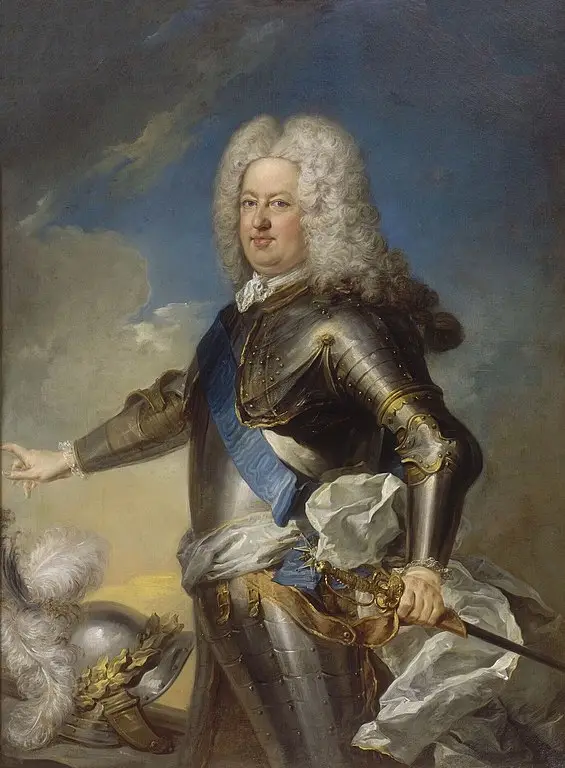
Stanislav I Leszczynski - King of Poland and Grand Duke of Lithuania in 1704-1709 and 1733-1734, then Duke of Lorraine in 1737-1766, father-in-law of King Louis XV of France. Artist Jean-Baptiste van Loo
Reign of Augustus III of Saxony: further decay
The importance of Poland under the reign of Augustus III (1734-1763) fell even further. He, like his father, preferred to live in quiet Saxony rather than in violent Poland. In addition, the new king did not have his father's political abilities, but inherited from him his passion for luxury and art. He spent enormous sums on purchasing paintings from the Dresden Gallery and other famous museums and maintaining a brilliant court.
The treasury was still plundered by high dignitaries. Thus, the head of the government was the vain and greedy Heinrich von Bruhl. With the help of his henchmen, he carried out operations with certificates of payment of taxes that were ruinous for the country; the Ministry of Justice was mired in corruption. The minister spent huge sums of money on the king’s court staff, and even larger amounts on his own. Brühl paid his honor guard better than the monarch, kept 200 servants and gave the most luxurious dinners. As a result, the treasury was empty. In addition, Augustus waged unsuccessful wars with Prussia and suffered a number of brutal defeats.
Sejms also could not have a beneficial effect on the development of the country. Firstly, there was no strong executive power that could implement the decisions of the Sejms. Secondly, the principle of unanimity in decision-making (“Free veto” - lat. Liberum veto) led to the blocking of most proposals and paralyzed the work of the Sejm. From 1652 to 1764, 55 out of 48 Sejms were disrupted. Moreover, a third of them were disrupted by the vote of just one deputy. The deplorable state of the finances of the Polish-Lithuanian Commonwealth is characterized by the fact that in 1688 the coinage was simply stopped.
At the same time, the unity of the country was undermined by the Catholic clergy, who demanded new restrictions on the rights of Orthodox and Protestants. As a result, the Polish-Lithuanian Commonwealth was never able to create a unified power. The Western Russian population did not become full-fledged in Poland and looked east, to Russia. Orthodox and Protestants made up up to 40% of the country's population, so their oppression undermined the unity of the Polish-Lithuanian Commonwealth. Pan's oppression and religious persecution continued to cause uprisings in Western Russian regions. And the Protestants looked towards Prussia.
The degradation of statehood, problems in the economy and finances led to a significant weakening of the military power of Poland, which was once a serious military power. The Polish-Lithuanian Commonwealth practically ignored new trends in military affairs, which were used, for example, by Sweden and Russia. The effectiveness of rifle and artillery fire has increased significantly, and battle tactics have radically changed. Infantry, supported by field artillery, began to play a decisive role in wars. The role of cavalry decreased. As a result, the brave and quite skillful Polish cavalry was now unable to counter the regular armies of Prussia and Russia.
This led to the fact that in the second half of the 17th century. (the so-called Swedish Flood) and in the 18th century. Poland literally became a “passing yard” for the armies of neighboring powers. For years, the armies of Sweden, Russia, Saxony, Prussia and the Ottoman Empire fought on Polish territory with the support of the troops of the Crimean Khanate.
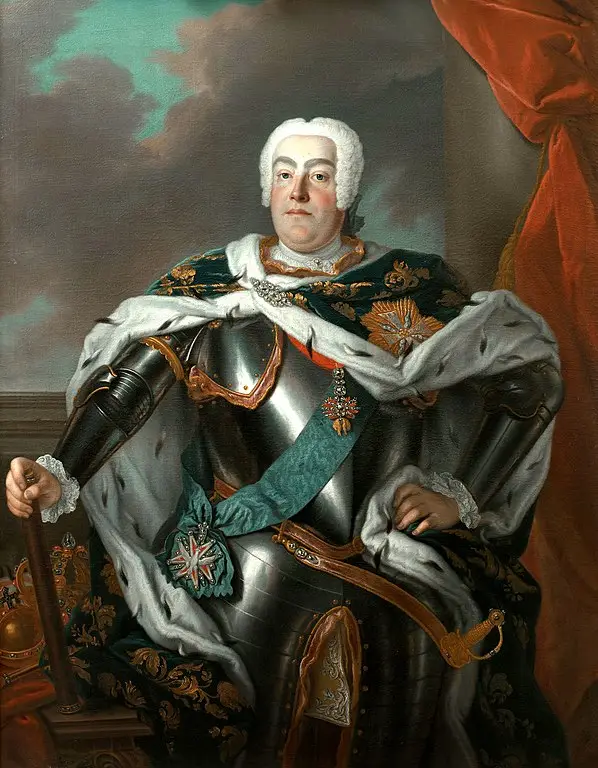
Portrait of the King of Poland and Grand Duke of Lithuania Augustus III (1696–1763). French artist Louis de Sylvestre
Russia's interests
Russia, which had noticeably strengthened its military-economic potential, could not remain indifferent to such a situation on its western border. The degradation of Poland led to the fact that enemy armies quietly walked across its territory, using Polish territory as a springboard for attacks on Russia. Thus, the Crimean Tatars regularly passed through the lands of Southern Poland and often crossed from there to Russian lands.
Warsaw itself could join the enemies of Russia at any moment. During the Northern War, Stanislav Leszczynski fought on the side of Sweden. Poland was greatly influenced by France, hostile to Russia. And the strengthening of Austria and Prussia at the expense of the Polish-Lithuanian Commonwealth did not bring anything good to Russia. We must not forget that Warsaw owned vast territories that were once part of Rus'. They were still inhabited by Russian people. It is clear that it would be stupid not to try to change the situation on the western borders in our favor.
St. Petersburg also had other, smaller claims against the Polish-Lithuanian Commonwealth. In particular, border disputes. So, in 1753, they conducted a study of the area and found out that about 1 thousand square miles of Russian land illegally remained in Polish possession. They belonged to Russia according to the Eternal Peace of 1686 and were supposed to be part of the Starodub, Chernigov and Kiev regiments. This gave rise to constant controversy. The Poles arbitrarily settled 10 cities on the Right Bank, which, according to the treaty of 1686, were considered controversial and therefore were not subject to settlement. Until 1764, the Polish Sejm generally refused to ratify the Perpetual Peace of 1686.
Poland was also the last of the European powers that did not recognize Russia’s imperial title, which Peter the Great assumed in 1721.
The relationship between the two Slavic powers was also clouded by the problem of the flight of Russian peasants to Poland. Thousands of Russian people fled to Poland. In the areas west of Smolensk alone, about 120 thousand people were accepted. This contradiction should not be surprising. In Poland, the Orthodox population was really oppressed, and the Polish lords very harshly enslaved the local peasants (khlops). However, peasants and deserters from the Russian army (again peasants) fled to Poland.
There are several reasons for this. Firstly, the Polish gentlemen had different attitudes towards their old claps and fugitive “Muscovites”. New arrivals initially received some benefits so as not to discourage them. Fugitive soldiers could generally be enlisted in their private troops. Secondly, in Russia in the 18th century, classical serfdom finally took shape. The peasants lost their former liberties and responded with flight and unrest. Thirdly, there were constant wars, there were many deserters.
As a result, the situation at the border was difficult. In the areas bordering on the Russian empire, thousands of thieves have accumulated who regularly made raids for the cordon. The pans either closed their eyes to it, since the robbers shared with them, or it was their troops, made up of runaway soldiers.
The Romanovs and Western Rus'
It is interesting that Moscow and St. Petersburg under the Romanovs did not particularly strive to become “gatherers of Russian lands.” If the Russian sovereigns of the Rurik dynasty from Ivan III to Ivan the Terrible tried to reunite all the Russian lands that were part of Ancient Rus', the Troubles interrupted this process. Mikhail Fedorovich only wanted to return the lands that Poland had taken away during the Time of Troubles, but was defeated near Smolensk. Tsar Alexei Mikhailovich refused to support the onslaught of the Cossacks in the Black Sea region and for quite a long time did not want to interfere in the affairs of the Polish-Lithuanian Commonwealth, when the uprising of Bogdan Khmelnitsky began there. Only when the uprising took on the character of a large-scale war of liberation and led to great successes did Moscow pay attention to it.
Tsar Peter Alekseevich completely forgot about the Western Russian lands. During the Northern War, Poland was in such a terrible state and, moreover, went over to the side of Sweden that not a single Russian soldier was needed to return a significant part of Western Russian lands. The Cossacks could easily cope with this task. However, Peter spent all his strength in order to cut through the “window to Europe”, and having cut it, he did not even take a significant part of Finland and the Baltic states, although he could. In addition, he dreamed of establishing himself in Germany. For this purpose, he patronized the German barons and organized a series of dynastic marriages with the rulers of the German states.
Peter's attention was almost entirely focused on Europe. Only in the last period of his life did he turn his attention to the East, which promised Russia much more strategic and economic benefits.
Anna Ioannovna and Elizaveta Petrovna were also more interested in German and Western European affairs in general than in the problem of reunification of the Russian land. Elizabeth even annexed East Prussia to Russia, only her death stopped this process.
Politics of Catherine the Great
Only Catherine II, realizing the futility of Russian intervention in German affairs, began to actively work in the Polish direction. She even renounced hereditary rights in Holstein for her son Pavel. An intelligent woman began to gradually cleanse the state apparatus from the dominance of the Germans, replacing them with Russians, or, in extreme cases, talented representatives of other nations. None of Ekaterina Alekseevna’s many German relatives received a responsible position in the empire.
At the end of the 1750, King August III became sick often. Polish magnates thought about his successor. The king himself wanted to hand over the throne to his son Friedrich Christian. The Saxon party was headed by the head of government, Brule, the great marshal, the crown count Mnisek, the hetman Branitsky, and the powerful genus of the magnates Potocki.
The Czartoryski (Czartoryski) clan opposed them. They were descended from the son of the Grand Duke Olgerd. The Czartoryskis proposed carrying out a number of reforms in Poland. Chief among them was the transfer of the throne to the Piast dynasty, the first Polish princely and royal family, which ruled Krakow until 1370, when King Casimir III died. There were no legitimate descendants of this dynasty, and the Czartoryskis had no relation to it, but in St. Petersburg they turned a blind eye to this and supported the idea. In Russia they were ready to support any loyal tycoon. The Czartoryski political group was named “Family”.
The Czartoryskis were also supported by Stanisław Poniatowski, the voivode Mazowiecki and the castellan of Krakow. Stanislaw Poniatowski, like the vast majority of Polish magnates, had no moral principles and acted solely for reasons of his own benefit. In his youth, he sided with King Leshchinsky and fought on the side of the Swedes in the Battle of Poltava. Then Poniatowski fled to Turkey with the Swedish king, where they both incited the Sultan to start a war with Russia.
Seeing that the map of Leshchinsky was bitten, he went to King Augustus II. His career growth was facilitated by his marriage to the daughter of Kazimir Czartoryski. After the death of King Augustus II, Poniatowski even tried to climb into the kingship. Realizing that he would not be king, he again bet on Leshchinsky and ended up with him in besieged Danzig. But he lost again. After being confirmed as king, Augustus III joined the Czartoryski Family, becoming one of the main advisers to the new king.
The fourth son of the Castellan of Kraków, Stanisław August Poniatowski, made a dizzying career. He traveled extensively throughout Western Europe, spent a long time in England and became a protégé of the English ambassador to the Saxon court, Charles Hanbury Williams. In 1755, William was appointed ambassador to St. Petersburg and took the young Poniatowski with him. After fruitless attempts to find approaches to Empress Elizabeth Petrovna and the future emperor, the Briton turned his attention to Catherine. Poniatowski became the Grand Duchess's favorite. Even when Williams left St. Petersburg, Poniatowski remained. Moreover, his connection with the Grand Duchess was not a secret even for her husband, Peter. He did not have any feelings for his wife, and even the four of them (with Peter’s mistress) went on a drinking spree. Peter and Poniatowski were friends during this period. Only when rumors spread throughout the capital and the French ambassador began to openly make fun of the situation did Empress Elizabeth expel Poniatowski from Russia. After his departure, Catherine continued to correspond with him.
After the coup of 28 in June 1762, when Peter was overthrown, and Catherine took the throne, Poniatowski wanted to return, but the Empress stopped him. She said that it was dangerous to come to Russia, Poniatovsky could simply be killed. The place of Catherine took Orlov brothers. There could have been a negative reaction from the nobility - a Pole at the throne of the Russian empress would be too strong an irritant.
At this time, the confrontation between the “Family” and the court party intensified in Poland. The Czartoryskis accused “Saxon” ministers and officials of abuses. The court party threatened the magnates with arrest. In response, Catherine promised Warsaw “populate Siberia"enemies of Russia and "release the Zaporozhye Cossacks", who want to take revenge for the insults suffered from the Polish king. At the same time, the Russian empress asked the Russian ambassador to restrain the Czartoryskis’ zeal. The army was not ready for war, finances were in disarray.
King Augustus III's health continued to deteriorate. On February 3, 1763, a state council was held in St. Petersburg. Almost all the dignitaries supported “Piast”. Only Count Bestuzhev-Ryumin tried to support the candidacy of the son of the dying king. The Council decided to concentrate a 30-strong army on the border with the Polish-Lithuanian Commonwealth and keep another 50 soldiers on standby.
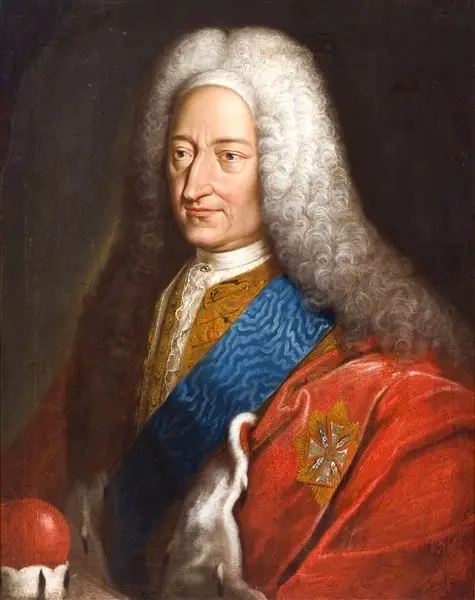
Prince Kazimierz Czartoryski (1674–1741) - Grand Treasurer of Lithuania (1707-1710), Lithuanian sub-chancellor (1712-1724), castellan of Vilnius (from 1724), organized (1730s) the magnate group of the Czartoryskis and related families (“Family "), which, counting on Russia's help, sought to strengthen the political system of the Polish-Lithuanian Commonwealth
Queenlessness
On October 5, 1763, Augustus III died. Hetman Jan Klemens Branicki raised the crown army, which was supported by Saxon troops. In response, “Family” asked Catherine to provide them with military assistance. First, they decided to send a small detachment that was already in the Polish-Lithuanian Commonwealth to the residence of the crown hetman in Bialystok. About 1,5-2 thousand soldiers guarded the warehouses left after the Seven Years' War.
At the beginning of April 1763, additional forces were introduced into the Polish-Lithuanian Commonwealth. The first column under the command of Prince M.N. Volkonsky went through Minsk, the second under the command of Prince M.I. Dashkov - through Grodno. On April 10 (21), 26 Polish magnates sent Catherine a letter in which they fully supported the entry of Russian troops.
On March 31 (April 11) a Russian-Prussian defense treaty was signed in St. Petersburg. Prussia was obliged to pay Russia annual subsidies (400 thousand rubles per year) in the event of a war with the Crimean Khanate or Turkey. They agreed to elect Stanisław Poniatowski as king in Poland. Prussia and Russia agreed to respect the existing order and laws in Poland. “Dissidents” (Orthodox and Protestants) should receive the same rights and liberties.
At the end of April, senators, deputies and lords began to gather in Warsaw for the convocation Sejm. The Convocation Sejm (from the Latin convocatio - convocation) in Poland was called the Sejm, which was convened after the death of the king by the Archbishop of Gniezno (Primate of Poland), the first in rank among the senators, who performed royal functions during the “kinglessness”. The task of the convocation diet was to maintain order until the election of a new king. The election itself was carried out on another, so-called. electoral (election) Sejm.
Many arrived with their private detachments. So, the governor of Vilna, Prince Karl Radziwill, brought a 3-strong detachment. Russian troops were also stationed nearby. On April 26 (May 7) the Sejm opened. Warsaw at this time was divided into two hostile parties, ready for battle. The Saxon party filed a protest due to the presence of Russian troops. They wanted to disrupt the start of the Sejm, but it didn’t work out.
The success of Russia, Prussia and the "Last Name" was also promoted by the death of Augustus’s successor, Friedrich Christian. Frederick Christian became Elector of Saxony in October 1763, but after only two months of reign died from smallpox. Only hetman Branitsky could now become the main opponent of Stanislav Ponyatovsky.
In June, the 1764 of the year ended the convoy seym. The prince of Czartoryski, the Russian governor, was elected Marshal of the Crown Confederation. The Sejm decided not to allow foreign candidates and to choose only from Polish gentry. In addition, the Seym, in gratitude for the support of St. Petersburg, recognized the imperial title for Catherine.
The detachments of Radziwill and Branicki were defeated by Russian troops. Both tycoons fled outside Poland. Under pressure from the Russian and Prussian ambassadors, Stanislav Poniatowski became the first candidate for the throne. In August 1764, the electoral diet passed quietly. Count Poniatowski was unanimously elected king under the name Stanisław II August Poniatowski. Thus, the Polish-Lithuanian Commonwealth came under the control of Russia and Prussia.
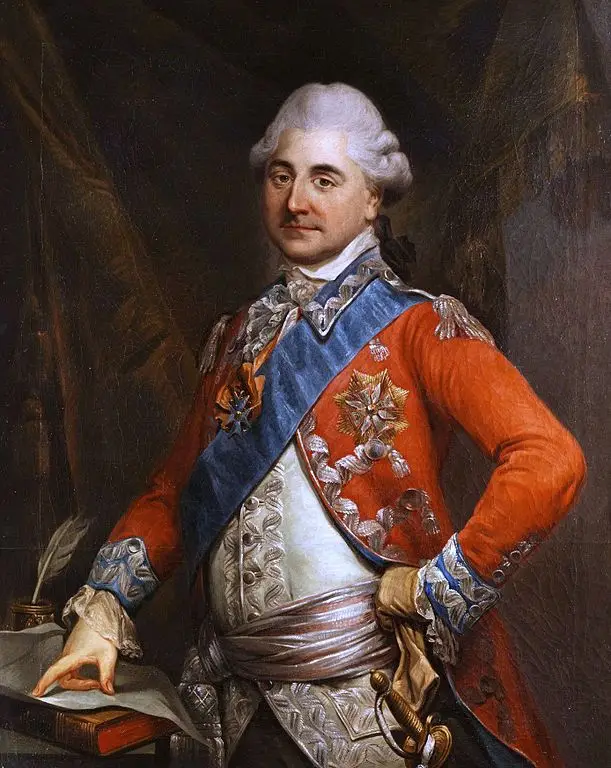
Stanisław II August Poniatowski was the last King of Poland and Grand Duke of Lithuania in 1764-1795. Hood. Marcello Bacciarelli
To be continued ...
Information